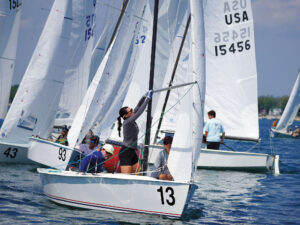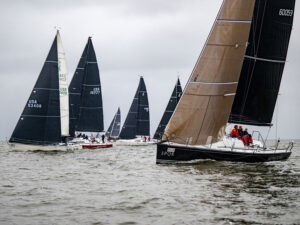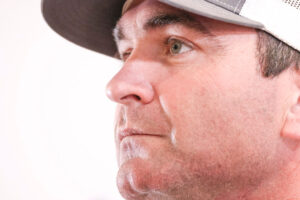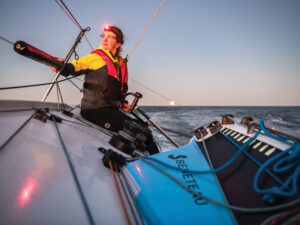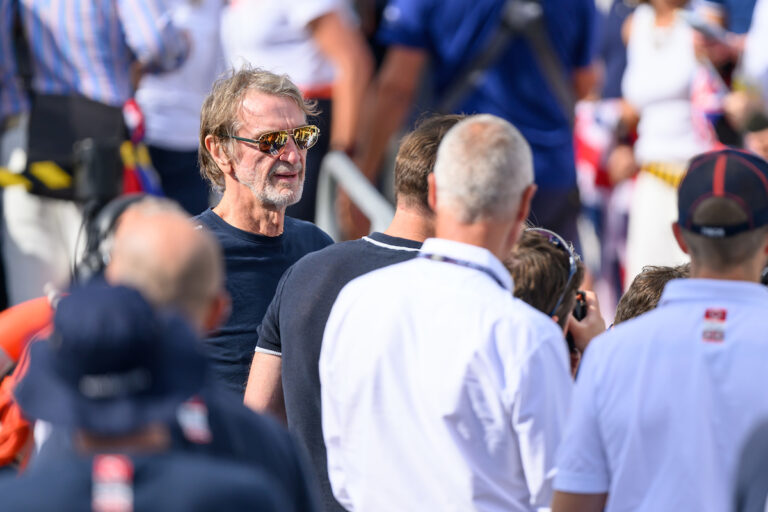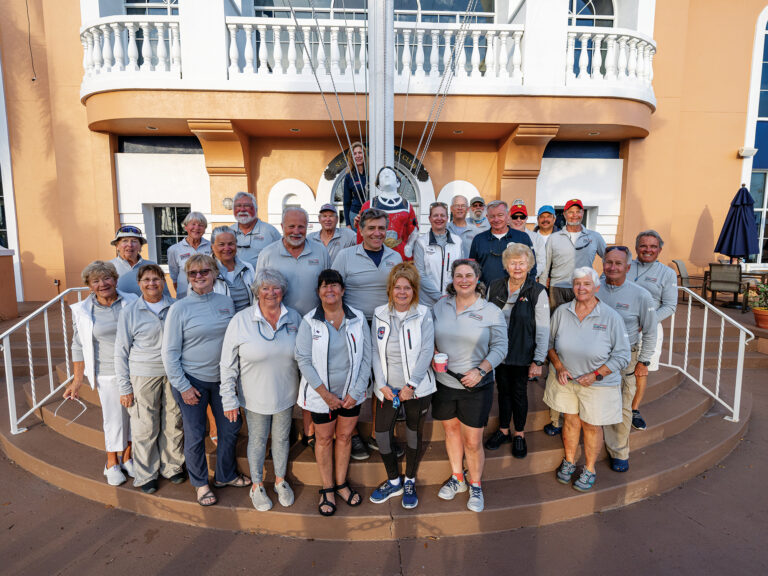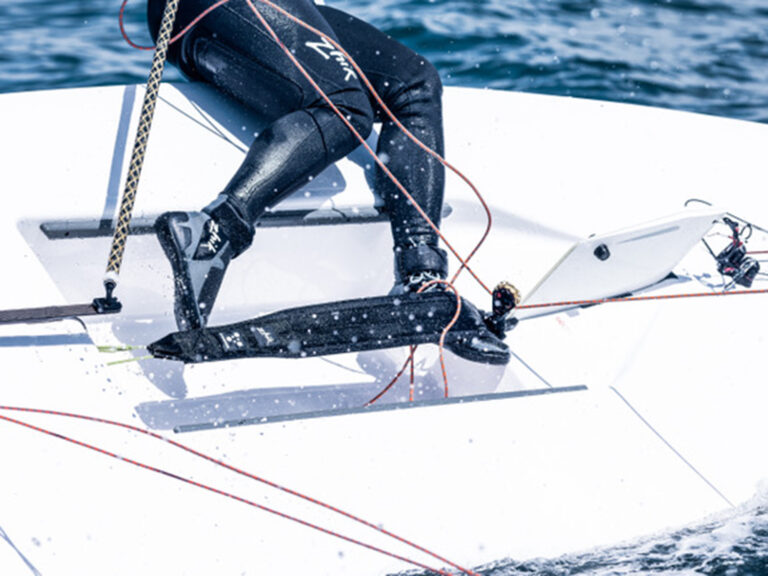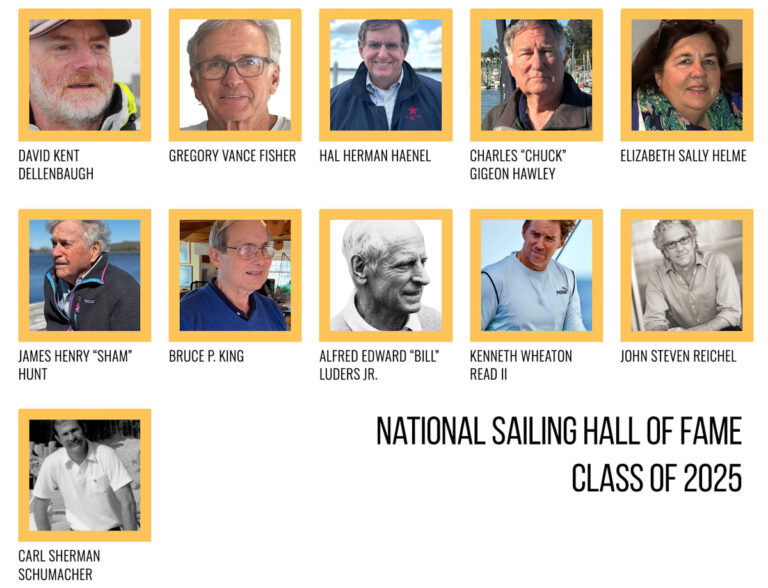Maybe Russell Coutts was saying, “Hey, what do you think of this cool custom carbon tiller extension? Did I show you how they inlaid my initials in gold? What a nice gesture by the guys at Core Builders.”
Or perhaps he was trying to get me to notice how light a touch on the helm it took to drive the AC45 catamaran in typically blowy San Francisco Bay conditions.
But where I come from when someone looks you in the eye and then points to the tiller, it means only one thing: “Do you want to drive?” And when the boat in question is an AC45, the hottest, fastest, coolest, course-racing boat on the planet, there’s only one way to answer: “Hell yeah!”
Actually, that’s not how I answered. Heading upwind at 17 knots in 25 knots of breeze meant that there was somewhere north of 35 knots of apparent wind screaming over the deck. You could only hear someone if you were right next to them and screaming. And even then it would be a toss up between: “Of course I want to drive?” and “Worst spot to have a hive.” And like switching between boats in a rough sea, this was no time to be tentative, or misunderstood. So I didn’t bother to open my mouth. I tried to let my actions talk for me. As quickly as I could move—which is fairly slow when the surface is a very spare rope mesh bouncing over a choppy sea at a ridiculous speed—I climbed from the spectator position behind the aft crossbeam to the helm station, a distance of about 10 feet, grabbed the aforementioned tiller extension, and held my breath.
With the AC45s needing to go from their birthplace of New Zealand to Cascais, Portugal, the site of the first event of the America’s Cup World Series in early August, Oracle Racing took the opportunity to spend some time sailing the speedy cats on San Francisco Bay, the site of the 34th America’s Cup in 2013, doing a little research and development and some public relations.
Monday was mostly about the latter. The team held a press conference with some key team members in the morning, then shuttled a dozen or so lucky press folk through the two boats for a test sail.
I was the final of the four guest racers on my RIB to board the Russell Coutts’ AC45—aka the old guy boat, with Kiwi mates Simon Daubney, Murray Jones, and Matt Mason among the crew. Ahead of me were Capt. Cynthia Stowe, the Sector San Francisco Commander for the U.S. Coast Guard and Bernie Wilson, a longtime sailing writer for the Associated Press. To say that both came off the boat impressed would be an understatement. However, neither are sailors, so I was curious to see whether I would agree with them.
I spent the past weekend racing in the New York YC’s 157th Annual Regatta on a NYYC/Club Swan 42, which is a rather appropriate working space for 10 or 11 crew. The AC45 is a shade longer, a lot wider, and yet seems to have about one-tenth of the working space. The guest racer sits aft of the aft crossbeam on about 2.5 feet of mesh. The five sailors spend most of their time hanging over the side of one of the two hulls. For the media sails, a sixth crewmember was also on board. For racing, however, there will only be five.
“Hang on to that carbon fiber post rising off the aft crossbeam,” said Russell Coutts as I boarded. “But grab the base. If you grab the top, it’ll break off.”
I shared my postage-stamp-sized space with a small suitcase of communications gear. Getting comfortable wasn’t really an option, so I kneeled down and tried to find something to grab on to that wouldn’t, when eased or tightened, take off my fingers.
The team sheeted in, and we blasted upwind into a stiff chop at 16 knots. Like any very light displacement boat, the movement in choppy seas is a bit jerky, but not nearly as bad as I expected. There doesn’t seem to be the flex in the platform that you see with other large cats, and when it’s going well, it’s fairly smooth.
The first few tacks were awkward. I was ready to chalk that up to simply it being a catamaran, and then Russell Coutts and crew nailed a tack and it wasn’t a whole lot slower than in a comparably sized monohull. “There’s a big difference between when you get a tack right and when you get it wrong,” Coutts yelled from the rail.
The crew work is intense. I was a little skeptical of John Kostecki’s comment in my most recent Sailing World Podcast that his first responsibility as tactician is to make sure the boathandling goes correctly. But after a few minutes on the boat I saw exactly what he meant. It takes all five guys to get the boat around the course, even the helmsman tails and grinds on occasion. Its furled sail can be hoisted into position just about any time on the upwind leg, though it does create a bit more drag when rasied. Coutts’ team raised it on the final approach to a mark. By the time Coutts yelled “Deploy!”—after we’d rounded a mark and jibed—the sail was two-thirds of the way out.
Downwind, the boat is frighteningly fast. But again, the movement is fluid. We were quickly into the low 20s, then when Coutts really found the groove, the mid 20s, topping out at 27 knots (a new personal speed record, not that I had anything to do with it) before we furled and headed back upwind.
After a few minutes of upwind sailing, Coutts looked at me and pointed to the helm.
I wasn’t sure what to expect when I took the helm. Coutts either has a fair amount of confidence that I can sail, or—and this is more likely—a lot of confidence his boat is quite easy to steer. And it was. The helm was surprisingly light, but not without feel. The boat tracked upwind better than any boat I’ve ever sailed. I sat down and tried to keep the tiller exactly where Coutts left it.
“16 knots,” said Murray Jones, who was on the main sheet, pointing out the speedo on the forward crossbeam. It felt a little high to me, and the inside telltales were all lifting, so I put the bow down a little bit. That brought the speed up to 18 knots in a hurry and a quick reminder from Jones that my target was 16 knots, not 19. Keeping the boat going upwind at pace was amazingly easy. Jones controlled the angle of the wing, keeping the windward hull just out of the water. He seemed to be able to do it almost subconciously.
After about a minute Coutts started prodding me to hike a bit, which I tried, sort of. At that speed, rudder movements have to be subtle. Among the key skills to sailing this boat is the ability to keep the rudder very straight while moving around.
After a few minutes, America’s Cup Hall of Famer Simon Daubney suggested I turn downwind. I think he was kidding. Either way, Coutts wasn’t going to let me pilot his baby through the death zone, which was probably a good thing. I was still shocked he let me steer in the first place. I relinquished the helm and got onboard the crash boat.
All kidding aside, it didn’t take much longer for the AC45 to show its ugly side. A few hours later, while maneuvering during a pre-start in the middle of the Bay, Coutts sent his AC45 “down the mine” resulting in one of the the most spectacular pitchpoles ever caught on tape. Oracle Racing crewmember Shannon Falcone was injured in the capsize. Fortunately he was able to walk off the rescue boat and, according to team officials, had no significant injuries. But it was a very real reminder of the danger of these 45s, and the exponential danger of a capsize in the 72s, where falling from the windward hull will be like jumping from a 10 meter diving board, or higher. And that’s if you don’t hit the wing or another part of the hull on the way down.
Your grandfather’s America’s Cup? Heck, this isn’t my America’s Cup, though I did immensly enjoy my brief moment at the helm. And it’s probably a very good thing. But it doesn’t come without its risks.

